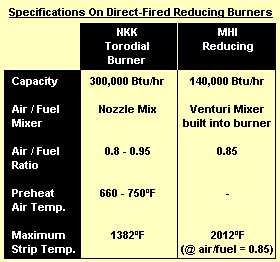Heat Treating: R&D Trends

Adapted from Steel Mill Process Heating Technology Study
Hatch Associates, GRI, 1995, p.6-4
Equipment
Combustion Technology
Energy Consumption
Process Description
R&D Trends
Improved Direct Fired Reducing Burners
Current practice for Selas direct fired reducing burners are limited to strip temperatures of 1022°F. As the steel temperature and residence time increase, surface oxidation is unavoidable. Therefore, radiant tube burners must be used in the hotter furnace zones. Nippon Kokan (NKK) and Mitsubishi Heavy Industries (MHI) have claimed improvement to the process that allows increase in the temperature to 1382°F and 2012°F respectively. The burners use air/fuel ratios of 0.8 to 0.95 which should theoretically promote oxidation. However, the short residence time of the strip (less than 25 seconds) promotes reduction due to the faster kinetics for reducing reactions versus oxidizing reactions. Direct fired reducing burners are able to remove surface oil without carbon residue, reduce the required length of the furnace, reduce the consumption of reducing atmospheres, and provide lower NOx combustion. The heat transfer coefficient of the direct-fired reducing burners is five times higher than that achieved by radiant tube burners.
De-Oiling Cycle for Batch Annealing
GRI, Thermotech, Indugas, and Lee Wilson are working on de-oiling cycle for batch annealing that improves the effectiveness of the steel surface cleaning processes that take place during batch annealing. The technique involves applying a vaccuum cycle to the inner bell during the initial heating resulting in more effective removal of oil at lower temperatures, minimization of carbon deposition on the steel, and reduction of gas consumption during heating due to elimination of the nitrogen purging steps. The process is being tested by U.S. Steel.
Semi-Continuous Annealing
A.G.A. laboratories is evaluating a semi-continuous strip annealing furnace that combines the simplicity of batch annealing with the even heating and speed of continuous annealing. The furnace consists of a coiler/unwinder combined with a preheating section, heating section, and a coiling section. The process would be undertaken under an inert atmosphere.
